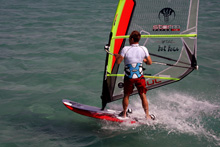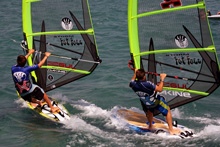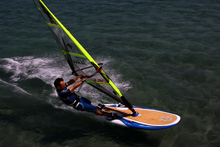NEW TO WINDSURFING? Do you want the best possible introduction to the sport? BOARDS Mag is here to guide you…
- It’s never been easier to learn, burn and turn!
- We’ll give you the knowledge, guidance and inspiration to get the most out of the sport.
- Get ready for a mix of magazine and online tips, tricks and all you need to make your initial moves on a board!
To help you through your journey we turn to BOARDS technique editor and internationally recognised coach Simon Bornhoft.
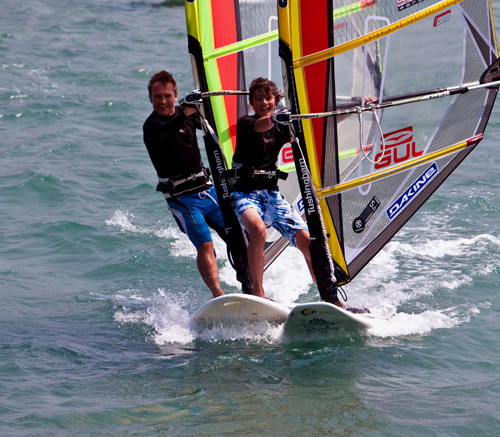
“Modern equipment and coaching techniques mean you, your friends and your whole family can enjoy the sport!”
EASY DOES IT
“The board’s are so much bigger and stable, when you fall off, you don’t fall in! It’s brilliant!” cheerfully exclaimed a recent newcomer. While staying dry isn’t guaranteed, the technical advances in equipment for beginners and enthusiasts is astounding. Windsurfing is now so much easier and more achievable than ever. Boards have become lighter, wider and much more stable leading you into more progressive areas of the sport with less effort and in a shorter time scale.
On your first day you’ll soon be windsurfing back and forth!
In 2-3 days you’ll increase your control, speed and be hooked!
In a week you’ll be calling yourself a true windsurfer, like thousands of others around the world!
REASONS TO WINDSURF?
- The buzz and thrill accelerating across the water, powered only by the wind, is sensational!
- There are schools and fabulous windsurfing locations all over the UK and around the world!
- You need nothing to get started!
- It’s a fantastic way to get fit, active and be on the water cheaply.
- You can buy complete second hand beginners boards from £300-500.
- With good guidance you’ll quickly gain confidence and new skills.
- There’s no greater day than one spent windsurfing!
MODERN KIT AND TERMINOLOGY
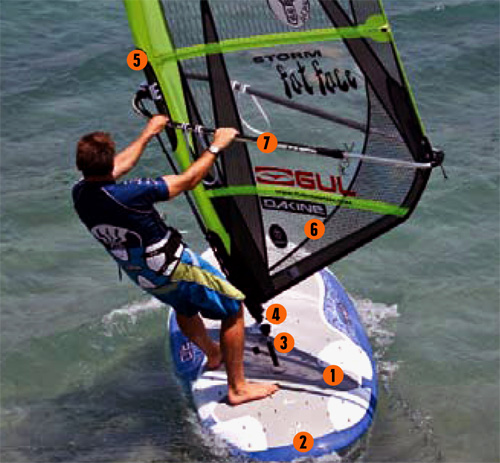
It can be confusing getting to know new lingo, but this is all you need to know for starters.
The Board = The floaty, stable platform you stand on.
The Rig = Refers to the combined components of mast, boom and sail.
1 – Board
Modern windsurfing boards are very stable, easy to sail and offer the perfect platform for quick progression.
The board you’ll learn on is likely to be 170-200L and approximately 85cm wide. Easy!
2 – Fin
The fin gives lateral resistance and helps you turn (where you want to go!).
3 – Daggerboard
Most beginners boards have a daggerboard which, like a yachts keel, give added stability and assists steerage in lighter winds. They can retract up into the hull, to reduce resistance, when you ‘plane’ at faster speeds.
4 – Mastbase
The mastbase, positioned approximately 135-140cm from the tail, connects the board to the rig.
5 – Mast
Carbon ‘masts’ are light and make the sail feel more stable, easier to handle and lighter in the hands.
6 – Sail
The clear ‘monofilm’ sails are light and measured in sqm’s. Beginners learn with sails 2.5-4.5m, then, once you’re past the initial stages you’ll can use larger 5-8ms sails in winds between 5-18knots. In stronger winds, 18-30knots, you’d use smaller 4-6ms sails. The first sail you might own would be between 5-6m depending on your stature.
7 – Boom
The ‘boom’ is what you hold onto and it should be set at shoulder-chin height, when standing on the board.
Windsurfing is for all ages and levels!
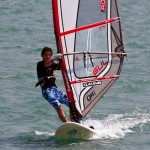
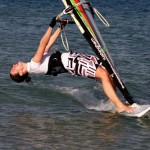
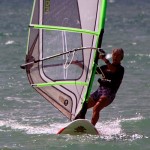
What Do You Need?
Most windsurfing schools provide all you need to get started when you take lessons. Once you decide to take up the sport (it won’t be long) your initial purchase would be a wetsuit, boots and buoyancy jacket.
Wetsuit
‘Blind stitched’, ‘Steamer’ or ‘smooth skin’ wetsuits, are glued and stitched to minimise water penetration through the seams, so they are warmer. ‘Over-locked’ or ‘double lined’ suits use a more basic stitching system which allows some water through, so they are used in warmer weather. A good compromise for the Spring-Autumn in the UK is a short arm, long leg blind stitched steamer.
Boots: Neoprene windsurfing boots are advisable to protect your feet.
Buoyancy: Although wetsuit give you buoyancy, most schools insist on you wearing a buoyancy jacket for your initial lessons/hiring of kit.
WINDSURFING PHRASES
Like every sport windsurfers have their own lingo, here’s two key phrases you might hear.
“What’s it doing out there?” This refers to the strength of the wind.
“What are you on? This asks what size of sail or board other windsurfers might be using.
WINDSURFING FACTS
Windsurfing is over 50 years old and was invented in the UK!
Top windsurfers can reach speeds of up to 50mph!
The largest wave ever windsurfed is higher than your house!
Intermediate windsurfers can easily blast around at about 25mph!
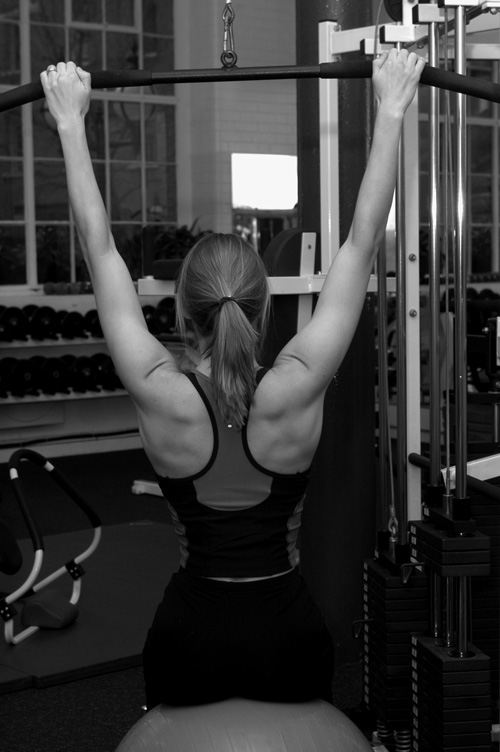
FITNESSWISE
Windsurfing is fabulous for toning, fitness, core strength and a very healthy lifestyle. Being on the water for a few hours beats being in the gym and you get an amazing feeling too! Recreational windsurfers burn approximately 200-400 calories per hour with a heart rate range of 110-175 bpm. Advanced windsurfers in the waves burn over 500-600 calories per hour, often reaching their max heart rate! Top Olympic Windsurfers require the same fitness levels as world-class athletes.
TECHNIQUEWISE
Not only has equipment changed, but improved teaching and coaching methods mean the skills you learn as a beginner can be used and applied to the highest level of the sport. Here are some of the key principles that you’ll hear use and should accentuate!
Windsurfing Principles

Vision – Always look forward in the direction of where you are going or want to turn.
Trim – Position the feet inboard and forward at low speeds, outboard and back at high speeds.
Balance – To create a counter balance, the body moves in the opposite direction to the rigs force and position.
Power – Sheet the boom, in back and down to help drive the board forward.
Stance – Forming a ‘7’ shaped stance is a good way to establish a strong stance.
SAFETY CHECK
Don’t go out in strong currents or offshore winds.
Wear a buoyancy when learning and never sail alone.
Get proper lessons and good guidance for a safer more enjoyable experience.
WHAT NEXT?
What are you waiting for? Check out our map for your nearest windsurfing school or centre in the UK to sign up for a taster session or full course. Further advice [email protected]

Seeing as he wrote the national coaching system and provides incisive technique features for BOARDS, it’s worth checking out Simon Bornhoft’s www.windwise.net for beginner improver / intermediate / advanced books, courses, fabulous holidays and advice.


